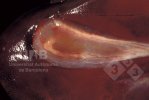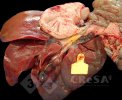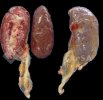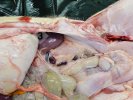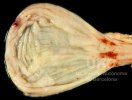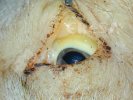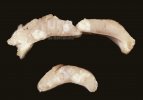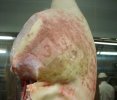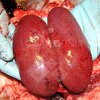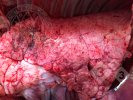
Recommendations for the prevention of african swine fever in at-risk countries II
In this second part the actions described are the ones needed when the disease is already in the country.
The pig sector events all around the world
Weekly newsletter with all the 3tres3.com updates
Swine industry news in your email
Pig health: news and articles on PRRS, PCV2, biosecurity, etc, Pig disease guide, atlas of pathology, clinical cases…
A visual and practical step-by-step guide on how to perform a necropsy on a pig.
Description of the most important diseases and conditions in pigs
Images of major swine diseases
Pig disease diagnostic tool
All the information about ASF: how to recognize the disease, how it is transmitted, pictures of lesions, latest news, guides, etc.
Definition for the most commonly used pig terms
Simulator that calculates the amount of drug to add to the water when using a flow dispenser.
Weekly newsletter with all the 3tres3.com updates
Pig Prices by countries. Pork production and trade. News of the pig market and the raw materials
The latest slaughter pig prices in the most important pig markets. Check the evolution of the historical prices in charts and in several currencies.
Figures & trends in pig numbers, pork production and pork trade.
Global production and trade data for the most important raw materials
Weekly newsletter with all the 3tres3.com updates
Articles on nutrition and pig feeding, characteristics of raw materials and additives for pig feed. Prices of raw materials
Definition for the most commonly used pig terms
Global production and trade data for the most important raw materials
Weekly newsletter with all the 3tres3.com updates
Articles on genetics and pig reproduction: genetic improvement, genomics, artificial insemination, use of hormones
Compare production data, calculate the number of sow, nursery, and finishing spaces, and visualize your tasks on the work schedule by type of BMS.
Definition for the most commonly used pig terms
Tool that allows you to calculate the replacement rate in your farm
Weekly newsletter with all the 3tres3.com updates
Management, pig farm management, work planning in each production stage: management in gestation, grow finish, batch farrowing
Compare production data, calculate the number of sow, nursery, and finishing spaces, and visualize your tasks on the work schedule by type of BMS.
Definition for the most commonly used pig terms
Weekly newsletter with all the 3tres3.com updates
Design of facilities and equipment for pig farms: building design, climate control, feeding systems, etc.
Definition for the most commonly used pig terms
Simulator that calculates the amount of drug to add to the water when using a flow dispenser.
Weekly newsletter with all the 3tres3.com updates
List of the most important diseases and conditions in pigs. Symptoms, causes, diagnosis, control and prevention of each disease are described. Some of the treatments mentioned may be prohibited in some countries. Information on all diseases to be completed in the coming days.
African swine fever is one of the most important viral diseases in pigs. It is a systemic disease and is notifiable on most countries.
African swine fever is caused by an Asfivirus. There are different strains with different virulence. Its clinical condition is quite similar to that of classical swine fever and many common diseases, such as salmonella, therefore a laboratory diagnosis is required. Its control involves the stamping-out. As with classical swine fever, these viruses survive for a long time in frozen carcasses.
Lactating piglets
Sows
Nursery and fattening

In this second part the actions described are the ones needed when the disease is already in the country.

ASF spreads mainly through the movement of infected pork and other animal products, as well as live animals, which includes wild boar.
World Organisation for Animal Health (WOAH) (2025) – WAHIS periodical extraction of early warning outbreak data. Retrieved on 12/11/2025. Data extracted by 333 Corporate 1998, SL. WOAH bears no responsibility for the integrity or accuracy of the data contained herein, not limited to: any deletion, manipulation, or reformatting of data that may have occurred beyond its control.
USEFUL INFORMATION
![]() University of Minnesota - ASF diagnostics - Jerry Torrison and Stephanie Rossow
University of Minnesota - ASF diagnostics - Jerry Torrison and Stephanie Rossow
![]() Travel responsibly to avoid carrying ASF virus
Travel responsibly to avoid carrying ASF virus
![]() Preparing for ASF / Risk Analysis - Topic 1: Foundations (IICA)
Preparing for ASF / Risk Analysis - Topic 1: Foundations (IICA)
![]() ASF in wild boar: ecology and biosecurity
ASF in wild boar: ecology and biosecurity
![]() FAO - Carcass management for small- and medium-scale livestock farms
FAO - Carcass management for small- and medium-scale livestock farms
![]() FAO - ASF in wild boar ecology and biosecurity
FAO - ASF in wild boar ecology and biosecurity
![]() FAO - ASF epidemiology and geographic information systems
FAO - ASF epidemiology and geographic information systems
![]() Pictures, clinical signs and pathological findings. EU Reference Laboratory for ASF
Pictures, clinical signs and pathological findings. EU Reference Laboratory for ASF
![]() ASF, a threat to the US Pork Industry (National Pork Board)
ASF, a threat to the US Pork Industry (National Pork Board)
![]() Laboratory protocols and algorithms for ASF virus
Laboratory protocols and algorithms for ASF virus
![]() Outbreak Costing Tool (OutCosT)
Outbreak Costing Tool (OutCosT)
![]() Indicative map of EU ASF regionalisation - Interactive
Indicative map of EU ASF regionalisation - Interactive


